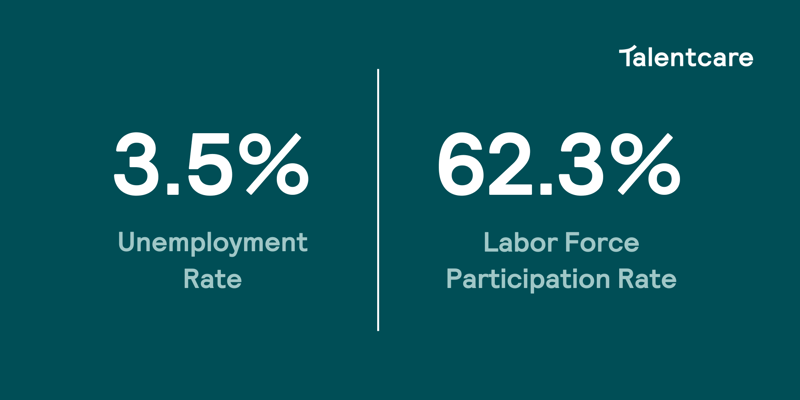Even as we see headlines about layoffs and hiring freezes, the labor market continues to surprise economists (and those of us who are working on headcount forecasting for next year). The U.S. Bureau of Labor Statistics reported on January 6th that total nonfarm payroll employment increased by 223,000 in December. The unemployment rate dropped slightly from 3.7% in November 2022 to 3.5% in December.
The labor force participation rate in December ticked up slightly to 62.3%, still 1% below its level in February 2020 before the COVID-19 pandemic began (this measure was largely unchanged throughout 2022).

Last year, the economy added a record 6.7 million jobs and tacked on an average of 457,000 a month more from January through July of 2022. Since then, hiring has cooled, to a monthly average of 277,000 from August through December. Yet it’s still consistently beating forecasters’ expectations. With nearly two job openings for every unemployed American, companies are struggling to find workers and retain the ones they have. A tight job market tends to keep upward pressure on wages and to feed into inflation.
If notable economists are stymied by how far their predictions are off, then how is your 2023 forecasting going? Overall, the labor market is still short 102,000 workers from before the pandemic, which could continue driving up wages as employers compete for a shrinking pool of employees.
But the Layoffs…?
Yes, there have been layoff announcements in a handful of sectors like technology, with large-scale job cuts announced at Meta, Amazon and Twitter. The Wall Street Journal reported in August that “People losing their jobs are rapidly landing interviews, multiple offers and higher pay, a dynamic of the tight labor market that is holding down unemployment totals.” (The Surprise in a Faltering Economy: Laid-Off Workers Quickly Find Jobs - WSJ)
For mid-sized companies, that means that top talent is out there, on severance, seeking new opportunities (like your job openings, for example). Want to scope out the tech companies laying off or get lists of employees now seeking work? Check out Layoffs.fyi.
One important note: You’ll want to search for lookalike companies with regards to culture and salary. The majority of newly laid-off workers are finding jobs rapidly, and most of them are getting a salary increase for doing so. If you have a database of recently laid-off workers, don’t expect them to settle for less than they made at the company they are now offboarding from. This might be a good time to do some research and find out just how competitive your salary ranges are before you include them on job postings. With salary discussions becoming more and more transparent, job seekers and your current employees have access to free online resources and apps that allow employees to share their open and honest opinions on a company, and salary is a major topic. If you’re lowballing salary ranges, chances are your current employees will move on and job seekers will seek elsewhere.
Standing Out from Your Competitors
So we know there’s recently laid-off top talent flying loose, flooding LinkedIn and email with “hello, I’m currently seeking new career opportunities” messaging. Companies like yours are running around with butterfly nets hoping to catch the attention of a few. We need a bigger net, which brings us to your employer reputation. What will these rare and precious butterflies see when they land on your company page on Glassdoor or Indeed?
We know that larger companies currently making layoffs are not getting great reviews on these sites (unless they’re Stripe). So what better time for you to strengthen your company’s reputation by managing it? Now is the time to develop a review response strategy.

Related Article: 7 Sites to Monitor Your Employer Reputation
According to Glassdoor, 86% of employees and job seekers research company reviews and ratings to decide on where to apply for a job and 75% of active job seekers are likely to apply to a job if the employer actively manages its employer brand. By “actively manage,” we mean responding to all reviews (the good, the bad, and the ugly), questions, and comments on employee review sites. It’s helpful to note that 76% of Glassdoor users agree their perception of a company improves after seeing an employer respond to a review, good or bad.
In this chaotic talent marketplace, can we afford to ignore reviews? Definitely not. But since we can’t have them removed from the internet, we need a reputation management strategy. That’s a big part of what we do at Talentcare and we’re ready to help. Drop us a line or slide into our DMs.
